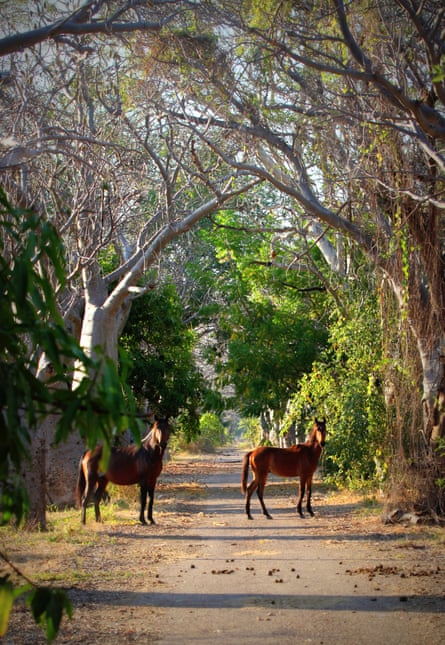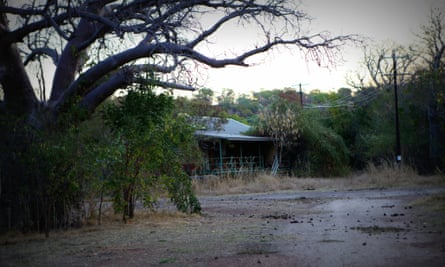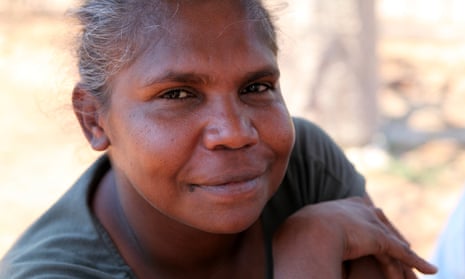Removing people from Oombulgurri was a gradual process.
First, the government closed the services. It closed the shop, so people could not buy food and essentials. It closed the clinic, so the sick and the elderly had to move, and the school, so families with children had to leave, or face having their children taken away from them. The police station was the last service to close, then eventually the electricity and water were turned off.
Finally, the 10 residents who resolutely stayed to the end were forcibly evicted, given just two days notice of eviction and allowed to bring only one box of belongings each. They had to leave behind cars, whitegoods, tools and personal possessions.
I saw many of these abandoned possessions during a research trip in September to what was by then a ghost town: a suitcase and a chair lying eerily in the middle of a road; personal documents strewn across the office; clothes, furniture and toys left in most houses; and children’s named artwork hanging on the walls of the school.
Oombulgurri lies on the banks of the Forrest River in the eastern Kimberley. The town is opposite a stunning slate cliff face, its wide streets are lined with Boab trees and hundreds of wild horses have taken over the area. Its population fluctuated over the years; at the 2006 census it was 107. The town had a clinic, shop, police station, school, office, power station, about 60 houses and large water tanks.

Residents described it as great place, where you could “catch two barras on one line”. They told me the community contains several Aboriginal sacred sites, including ceremonial sites, and a cemetery.
Oombulgurri is also the site of the 1926 Forrest River massacre of Aboriginal people. Its traumatic history continues in present times. During 2005 and 2006 four people killed themselves; a sexual assault taskforce and a Coronial Inquest went on to highlight incidents of domestic violence, suicide, child sexual abuse and alcoholism. Three individuals from the community were convicted of offences.
While the taskforce and inquest unravelled an undeniably grave social crisis, the coroner did not make a recommendation to close the town. Nevertheless, the Western Australian government did just that, and has begun demolishing Oombulgurri.
Oombulgurri is part of the Balanggarra native title claim, which was successfully determined in 2013 following a 20-year fight. The determination acknowledged the thousands of years that the Balanggarra people have cared for their country and promised them some right to it in the future.
Unfortunately for the traditional owners the determination did not include the Oombulgurri settlement, which is owned by the WA government’s Aboriginal lands trust, extinguishing native title. It was this loophole that allowed the WA government to forcibly evict traditional owners from their homelands.
The official line when Oombulgurri was closed in September 2011 was that it was “unviable”. Communication last month from the WA government to Amnesty International states Oombulgurri was closed due to severe dysfunction and to ensure community safety.
“Unviable.” That’s a term used by the WA government in recent weeks to justify closing up to 150 more remote Aboriginal communities. But as I have seen first-hand, there is nothing more “unviable” for Aboriginal people than to be forcibly evicted from their traditional lands and assimilated into white townships.

The WA government has said most residents left their homes voluntarily, a claim completely at odds with the testimonies we collected. Residents spoke of a lack of consultation, and said the process was rushed and did not seek the consent of those being evicted.
The claim of voluntary departure looks even hollower when you consider that the Balanggarra Aboriginal corporation, on behalf of 150 residents, has requested for people to return to their land and been refused by the Barnett government. In fact, they have been told they’ll be charged with trespass if they try to return.
To be disconnected from land and culture, often made homeless, and forced deeper into poverty, substance abuse, violence, lack of education, unemployment and ill health – that’s what it means to be “unviable”.
My visit to the town in September, a month before demolition commenced, was a continuation of Amnesty’s work on homelands. Our 2011 homelands report found huge benefits for Aboriginal people living on their traditional lands: connection to land and culture, self-determination, employment, improvements to physical and mental health, and a reduction in substance abuse and violence.
For example, people living on the NT’s Utopia homelands were found to have a 40% lower mortality rate than Aboriginal people in the NT generally, and a 50% lower rate of cardiac disease.
The eviction of the residents had the opposite effect. Many residents were left homeless and either camped or stayed with relatives throughout the Kimberley region. Three years later some residents are still homeless or not appropriately housed.

The children suffered the most from the eviction. On our visit we were told that most of the children from Oombulgurri who now live in Wyndham do not go to school. Many others have been removed by the department of child protection.
And teenagers had it particularly bad too. There were influences in Wyndham that weren’t easily accessible to them in Oombulgurri – as alcohol, drugs and petty crime like stealing cigarettes. Many were taken from their families or detained by police.
There are few liquor restrictions in Wyndham and many of the evicted Oombulgurri residents turned to alcohol.
The trauma felt by the people is evident. One of the last men to leave Oombulgurri took his own life in Wyndham. One of the last Elder women to leave still cries every day. Nearly everyone we spoke to expressed sorrow, disbelief and hopelessness. Many still can’t understand why it happened and yearn for their homeland.
As the inquest and taskforce showed, Oombulgurri had its problems. But the government did little to address violence and substance abuse in the community for years. A decade ago, when I visited Wyndham in my role for the WA department of commerce, I was told that it was open knowledge that planes regularly flew drugs and alcohol into Oombulgurri, and that the authorities were well aware.
The abuse of women and children were crimes, and those individual perpetrators were rightly dealt with in the criminal justice system. The entire community should not be punished for the heinous crimes of individual residents.

The WA government traumatised the women and children further when they were evicted from their traditional lands. Instead they should have invested in the community, by providing health, employment and social programs to help the residents and the township.
Despite community efforts, supported by Amnesty International, the bulldozers rolled into Oombulgurri last month. The WA government has literally dug a hole and in it buried the rubble of people’s homes and personal belongings. The process will soon be replicated in up to 150 communities across the state.
Living on the homelands is of such clear benefit for Aboriginal people and the whole state, that Colin Barnett’s decision to evict more communities will end in tragedy. In terms of reducing the burden on the health, welfare and justice systems, maintaining remote communities is a policy any government should support.
I urge all governments in Australia to open transparent discussions about the future of our communities that includes those in those communities. Making remote communities “viable” and safe is possible with will and creative thinking. The demolition of Oombulgurri must never be repeated in another community.
